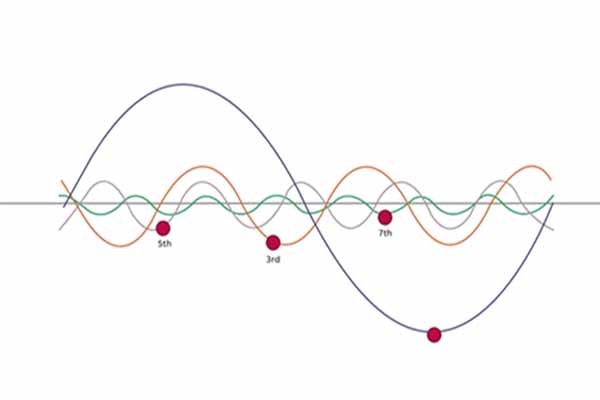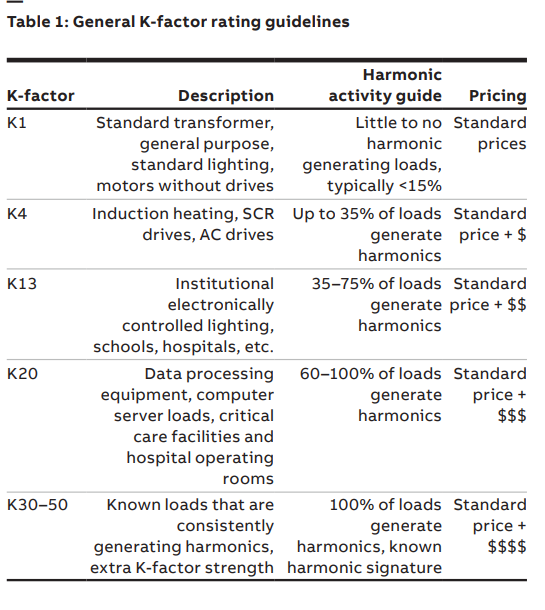In a standard AC power supply, an electrical signal takes the shape of a sine wave. This is what the electric equipment at the end of the line consumes and uses to do work (powering lights, running motors, printing, running computer programs, etc.). Notice the even shape of the wave in the image below; each peak and crest has the same amplitude. In a 60-Hz system, this wave cycles up and down 60 times per second.

In an electrical system, equipment consumes power linearly or nonlinearly. With linear loads, the consumption of power follows the same shape as the AC sine wave. If you think of the power supply like a sandwich, a linear load would eat the whole sandwich. Non-linear loads consume power in a way that does not follow the sinusoidal shape of the AC power supply (consuming certain portions of the wave shape at designated intervals). To use the sandwich analogy, non-linear loads may only consume a part of the sandwich, like the bun. Examples of linear loads would be motors or incandescent lighting. Examples of non-linear loads would be computers, electronic lighting ballasts, variable frequency drives, and fluorescent lighting. These non-linear loads and the particular manner in which they consume power produce harmonics.
As we discussed in the beginning, modern electronic equipment is designed to operate at a higher efficiency (meaning less power is wasted during operation). This is accomplished by what is known as use-based power consumption––the equipment automatically switches on for operation and then off again when it is not doing work. This on/off switching function introduces harmonics into the electrical circuit. Again, if we think of the AC power supply like a sandwich, electronic devices designed to operate only while in use will consume only parts of the sandwich. A lower amount of the total power supply is consumed, but the process required to do this produces a higher amount of harmonic content.
Harmonics introduce additional heat into transformers, leading to potential damage.
Transformers not designed to handle harmonics may face insulation degradation due to overheating. Additionally, the core experiences increased switching rates due to higher harmonic frequencies, which can lead to excess losses and thermal stress.
The third most common area of overheating in the transformer is the neutral conductor on wye-connected windings. With wye-connected systems, triplen harmonics (3rd, 9th, 15th, and so on) will be present. These particular frequencies are most often seen where transformers serve large single-phase loads. Any triplen harmonics present in one or more phases of the system will add together at the neutral conductor. These harmonics crowd together in the neutral and reduce its current-carrying capacity. If the amount of triplen harmonics is high enough, the neutral conductor will overheat and its insulation system will fail. For such cases, an oversized neutral is generally used.

K-factor rated transformers are specifically designed to handle the additional heat generated by harmonics. Unlike standard transformers, they feature a 200% rated neutral conductor to manage the higher currents produced by triplen harmonics. These transformers don’t eliminate harmonics but are robust enough to withstand their effects. Varelen offers K-factor ratings from K-1 (standard) to K-20, suitable for various commercial and industrial applications.
The K-factor is a measure that indicates the ratio between the extra losses caused by harmonic currents and the standard eddy current losses at 60Hz. This parameter helps in specifying transformers designed to support non-linear loads.
If the load is entirely non-linear, then a K-9 transformer would be more appropriate. In more demanding applications, a transformer with a K-factor of 13 can be considered to handle the increased harmonic content effectively.
As the K-factor rating rises, several trade-offs come into play.
Harmonic-mitigating (or zigzag) transformers (HMTs) do exactly what their name suggests: reduce the presence of harmonic currents in an electrical system. Unlike units designed with a K-factor rating, HMTs filter a portion of the harmonic content. The installation of a stand-alone HMT will reduce the amount of triplen harmonics (3rd, 9th, 15, etc.) present in a circuit. Installing an additional HMT on the same circuit with a -30 degree phase shift (when the first unit has a 0-degree phase shift, or vice versa) can further reduce the amount of 5th and 7th harmonics. This dual-unit phase shift method can also be accomplished with standard delta-wye transformers, but a zigzag winding offers a more economic solution. HMTs are generally used for systems that operate several non-linear loads.
In addition to K-factor rated and harmonic-mitigating transformers, Maddox also offers a passive harmonic filter, a combination of capacitors and reactors. A passive harmonic filter is used to reduce the harmonic current flowing through the main circuit pathway. It accomplishes this by providing a lower impedance path for the harmonic current to travel—the harmonic current is diverted away from the system’s bus, which, in turn, lowers the circuit impedance. Passive harmonic filters can be tuned for one or more particular harmonic frequencies in a given system, making them a more versatile solution than the HMT. Higher K-ratings for larger transformers can significantly increase the cost of a unit, so the passive harmonic filter may provide a more cost-effective solution. Diverting the harmonic current in the system away from the main current-carrying pathway allows for the installation of standard equipment throughout the circuit (including the distribution transformer).
For systems where only triplen harmonics are present, a standard delta-wye transformer may be a sufficient solution. As mentioned earlier, triplen harmonics often cause problems for the neutral conductor, but when a delta winding is present on the primary side of a two-winding transformer, the triplen harmonics will circulate inside the delta winding instead of the neutral conductor. If a study of the harmonic profile of a system shows that only 3rd, 9th, or 15th harmonics are significantly present, a standard delta-wye transformer will be a sufficient solution. A delta-wye transformer also eliminates the problem of zero sequence currents, which are characteristic of wye-wye connected windings. For this reason, delta-wye winding configurations are often favored for applications where the load may be unbalanced.
Another way to account for harmonic distortion in a system is to simply oversize the kVA of a standard transformer design. This is a quick and easy solution when it is not feasible to wait for a custom-built transformer from the factory with a designated K rating. For applications where the THD is minimal (K-4, for instance), a simple oversizing of the kVA—or establishing a derating factor—may work just fine.
At Varelen, we specialize in providing solutions to manage harmonic distortion, ensuring the longevity and efficiency of your transformers. With a range of products, from K-rated to delta-wye transformers, we have the expertise to help you make the right choice for your system. Contact us today to learn more or request a quote.